
It’s estimated that between 3,000 and 8,000 people in the U.S. have Vascular Ehlers-Danlos Syndrome (VEDS), although many are undiagnosed. Because 50% of those with the condition do not have a family history, the road to diagnosis and expert care can be long. Many individuals with VEDS are not diagnosed until they have a life-threatening event, and 80% of VEDS patients will experience a major medical event by age 40; too many are diagnosed during autopsy.
The likelihood of someone coming into the emergency department unaware of their VEDS diagnosis is high, but a VEDS diagnosis can change the approach to a patient’s emergency and surgical care and outcomes. Therefore, it is critical to be familiar with this condition. Here we present a missed diagnosis case and its impact on the invasive interventions.
Your Young Patient
A 23-year-old woman arrives in the emergency department with redness and pain behind the left eye. She tells the physician she has had a sinus infection for months that will not go away, but now her vision is starting to change in that eye and she can hear a pulsation in her head. The physician orders a CT angiography (CTA), which shows a carotid-cavernous sinus fistula (CCSF). Although the physician included traumatic injury in the differential diagnosis, the patient recalled no injury. The physician paged the vascular surgeon on call and prepped the OR.
Unplanned Complications
The patient was prepped for an angiogram after the surgeon told her it is a simple, routine procedure. The surgeon expected the angiogram to provide a better view of the CCSF and allow for a precise approach during surgery. The patient was young and healthy, and no one suspected any risk factors for the procedure.
Unfortunately, the procedure did not go as planned. First, the patient’s femoral artery tore at the entry site of the catheter. Then her other femoral artery ruptured; her aorta ruptured as well. Everything the vascular team repaired seemed to cause a tear in another location; they described it as touch and go. The young woman was placed into a medically induced coma and onto a ventilator while the team attempted to stabilize her.
The patient underwent twelve surgeries to save her life after the angiogram. Ultimately, the vascular team was not able to get to the carotid-cavernous sinus fistula. At this point, the patient had limited blood flow to her legs, but because she was finally stable, the vascular team did not recommend a final procedure to restore the blood flow. Luckily, the patient escaped this scenario with her life, but she lost all mobility and is dependent on a wheelchair. Following discharge from the hospital, the pressure in the eye caused by the CCSF was managed medically with eye drops for an extended period. The patient was lucky her eyesight eventually recovered; this does not happen in all cases.
Missed VEDS Diagnosis
Considering the multiple complications, the vascular team recognized that the young woman had faulty connective tissue consistent with VEDS that caused her arteries to be fragile. No one knew she had this condition prior to the angiogram. However, there were red flags the team missed when she came in to the emergency department, and the procedure could have been modified to be less risky if these signs had been recognized earlier.
Vascular Ehlers-Danlos Syndrome is a new course from The Sullivan Group through a collaboration with the VEDS Movement, a division of The Marfan Foundation; the course presents symptoms, signs, diagnostic criteria, red flags, and emergency presentations of VEDS. Recognition of these emergencies associated with VEDS prior to a surgical procedure can save lives and reduce your risk of medical error.


